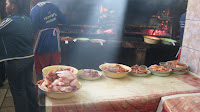I am a bit too tired to write a detailed entry (welcome back to the life of teaching), but I do want to share how the last few weeks of school have been. We spent last week observing classes to see how things work at the school, and this week we have had the opportunity to actually teach.
It has been a bit nerve wracking to enter into a new school with so many faces attached to long, confusing names that include a q…which represents a clicking noise (haven’t mastered that one yet!), but I am beginning to get my bearings. I have been lucky enough to work with an English/geography teacher named Mr. Minyi, who is also an interim administrator. On one of the first days he saw my hope in creating environmental lessons and handed over some geography textbooks. I was excited to see that much of the geography curriculum focuses on the environment and ecosystems. So, over the last week he has given me creative freedom to design cross-curricular lessons in both the 10th and 11th grade geography classes that focus on outdoor education.
In the 10th grade class we are creating a geological map of the campus. We are going to study different rock types and students are going to investigate where the rocks possibly came from. Since many of the rocks were mined, we are going to extend the lesson to incorporate a history lesson about mining conditions in South Africa. We may also take the students on a field trip to visit the historical gold mines in Jo’burg. I am super excited to see how this all turns out.
In the 11th grade class, students are studying the different ecosystems on campus. They are participating in nature observations and will then conduct research on specific species they find. Once they present their research, they will create a gigantic food web linking many of the species on campus….we’ll see how this lesson goes. These guys are not as excited as the grade 10 students…maybe I just have more of a knack with 10th grade students though.
This week we also led our first teacher training on using reflection as a means to judge the effectiveness of your lessons. It went pretty well. We will hold teacher-training workshops on the next three Wednesdays. Teachers from the township high schools will also attend. We are headed to observe a township high school tomorrow. I am really interested to see the difference.
A few days ago a few of our students gave us a tour of the township. To be honest it made me kind of sad that I cannot be staying in the township. Life there is much like it is in West Africa, very lively and communal. I loved seeing all of the street vendors, creative fashion and hearing all of the music bumping on the street. Mike was more than brave to drive Dolores…I probably would have hit someone.



















